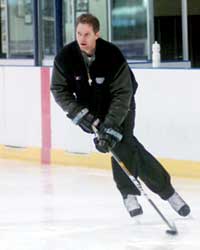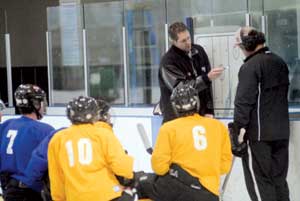WHITEFISH — When Murray Craven was growing up in Canada, every neighborhood had an ice rink and everyone played hockey.
“We could make a game up in about 15 minutes,” he said.
Playing for hours on end with his two brothers, day after day, Craven honed his skills and developed a love for the game that led to a successful 18-year NHL career.
These days his professional career is in the rearview mirror and the slap shot is a little rustier than it used to be. But Craven’s passion for hockey is still intact.
Some days it even seems like he’s spending as much time at Stumptown Ice Den as he did at the rink during his NHL days.
“I’m here a lot,” he said smiling recently inside the lobby at the local indoor rink. A few feet behind him, a couple of old pictures from his NHL playing days hung on the wall.
Craven has become a fixture at the popular ice rink, whether it’s as a coach for both his son and daughter’s youth teams, or to play in a men’s league game or to help brainstorm facility improvements.
 |
|
Murray Craven works the puck while helping coach a Glacier Nationals hockey practice at Stumptown Ice Den in Whitefish. Craven retired from the NHL in 2000 after 18 seasons and now spends his time volunteering as a youth hockey coach and board member of the Glacier Hockey Association, a non-profit organization supporting youth hockey in the valley. |
Craven enjoyed a long and successful career in the NHL, playing in more than 1,000 games and making three trips to the Stanley Cup Finals. In perspective, over half of all NHL players play less than 100 games and only roughly 4 percent play as many games as Craven, according to NHL statistics.
What set Craven apart?
In his words, it boils down to one word: passion.
“I tell anyone who ever asks for any advice, ‘If you don’t absolutely love the sport you’re playing, I don’t want to say it can’t happen, but there’s a good chance you’ll never be a professional,’” he said. “Because the sacrifice and the work load to get to the highest level, if you don’t have a passion for it you won’t put in the time and work to get there.”
Craven put in the work, first at the neighborhood ice rink and then at the junior level. That’s when people began noticing the 6-foot-2 center from Medicine Hat, Alberta.
“I don’t think I truly thought I’d be an NHL hockey player until I was probably 16-17 (years old),” he said. “Then all of a sudden scouts started talking to me. Before that I was just playing because I loved to play.”
The Detroit Red Wings drafted the 18-year-old with the 17th pick of the 1982 NHL Draft. Craven went on to play for five other teams throughout his career and amass 266 goals and 493 assists before retiring in 2000.
Craven often visited Whitefish with his family growing up for vacations during the winters and summers. Years later when he was looking for a place to live during the offseason he returned to Northwest Montana and bought a house that became his family’s full-time home after he retired.
“It’s been a good spot for us,” he said. “It made the transition (after retiring) kind of seamless. We already had everything set up. My kids don’t really know anything else other than living in Whitefish.”
Not long after Craven settled into town he returned to the ice. Stumptown was an outdoor rink at the time and had a long list of needs, including a roof. A group of hockey enthusiasts throughout the community came together and organized a plan to update the rink. Craven volunteered to be the fundraising chairman. The group raised $2.4 million and upgraded the entire facility to its current status before giving it to the city debt-free.
 |
|
Murray Craven outlines a drill while helping coach the Glacier Nationals at Stumptown Ice Den in Whitefish. |
“It was a tremendous cooperative effort by everybody,” he said. “Now we’ve got a great facility for a small town like we have. We have a very versatile facility that draws raves from everyone.”
Stumptown has become the valley’s hockey hub. The rink is used seven days a week from 6 a.m. to almost midnight. More teams are added every winter, including the new junior hockey program, the Glacier Nationals. Women’s teams have increased this year, too.
Craven and others would like to add new locker rooms to facilitate the constant increase in needs.
“We’re getting good use out of (Stumptown),” he said. “We’ve grown. (New locker rooms are) just appropriate growth for us.”
His motivation for helping make Stumptown a hockey hot spot goes back to his roots. If it wasn’t for those neighborhood ice rinks, he doesn’t know where he’d be today. Nowadays, Craven said, hockey isn’t as popular as it once was, even up north, but he believes the sport is regaining some of its old appeal. Hockey games are not on television as often as other sports, but that could be changing now that NBC has purchased Versus and plans to enhance the sport’s exposure.
For kids growing up the options seem limitless. Hockey can be expensive. That’s why youth players can use gear stored at Stumptown’s equipment bank instead of having to buy everything. Teams for all ages are available.
“That’s how it starts. You just develop a love for the game and take it as far as your ability and passion will allow you,” he said. “That’s what we’re trying to do here. If someone has that passion, we’ll get them playing.”
Bringing the Stanley Cup to town doesn’t hurt either. Craven’s friend Doug Houda is an assistant coach on the Boston Bruins. After the team won the Stanley Cup last season, Craven talked Houda into bringing the shiny silver trophy to Whitefish. In July, Lord Stanley’s Cup made an appearance at Stumptown.
“I bet we had about 3,000 people here,” Craven said. “We had a great time with it.”
Craven is one of nearly a dozen former NHL players who live in the area, although he’s one of the few who live here year-round. He goes to a few professional games a year and keeps in touch with friends still in the league. He still often watches the sport on TV. But mostly the 47-year-old father has a new focus and a new role, sharing his passion at Stumptown with his kids and others.
“I’m now a professional amateur coach,” he said laughing.